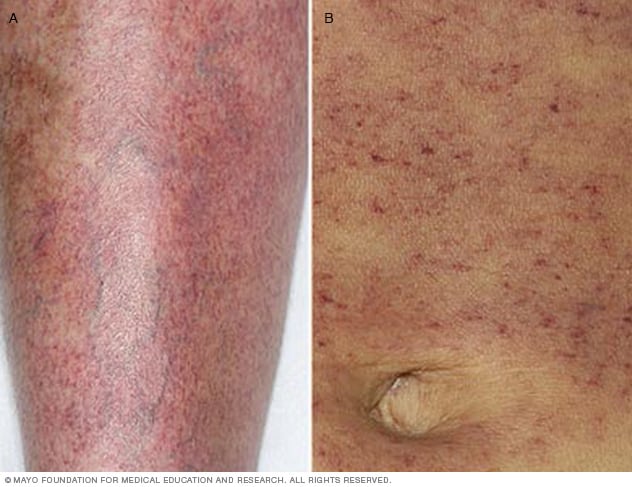Overview
Immune thrombocytopenia (ITP) is an illness that can lead to bruising and bleeding. Low levels of the cells that help blood clot, also known as platelets, most often cause the bleeding.
Once known as idiopathic thrombocytopenic purpura, ITP can cause purple bruises. It also can cause tiny reddish-purple dots on the skin that look like a rash.
Children can get ITP after a virus. They most often get better without treatment. In adults, the illness often lasts months or years.
People with ITP who aren't bleeding and whose platelet count isn't too low might not need treatment. For worse symptoms, treatment might include medicines to raise platelet count or surgery to remove the spleen.
Products & Services
Symptoms
Petechiae

Petechiae
Petechiae are tiny dots from bleeding under the skin that may look like a rash. On lighter skin, they may be red or purplish. On darker skin, they may be brownish or difficult to see. Here they appear on a leg (A) and on a belly (B).
Immune thrombocytopenia might not have symptoms. When symptoms occur, they might include:
- Easy bruising.
- Bleeding into the skin that looks like tiny reddish-purple spots, also known as petechiae. The spots mostly show up on the lower legs. They look like a rash.
- Bleeding into the skin that's larger than petechiae, also known as purpura.
- Bleeding from the gums or nose.
- Blood in urine or stools.
- Really heavy menstrual flow.
When to see a doctor
Make an appointment with your health care provider if you or your child has symptoms that worry you. Bleeding that won't stop is a medical emergency. Seek help right away if you or your child has bleeding that the usual first aid efforts can't control. These include applying pressure to the area.
Causes
Immune thrombocytopenia usually happens when the immune system makes a mistake. It attacks and destroys the cells that help blood clot, also known as platelets.
In adults, an infection with HIV, hepatitis or the bacteria that causes stomach ulcers, known as H. pylori, can cause ITP. In most children with ITP, the disorder follows a virus, such as the mumps or the flu.
Risk factors
ITP is more common among young women. The risk appears to be higher in people who also have other diseases in which the immune system attacks healthy tissues, such as rheumatoid arthritis or lupus.
Complications
Rarely, immune thrombocytopenia causes bleeding into the brain. This can be fatal.
Someone who's pregnant with a low platelet count or who's bleeding has a greater risk of heavy bleeding during delivery. A health care provider might suggest treatment to keep the platelet count even.
ITP doesn't usually affect the fetus. However, the baby's platelet count should be tested soon after birth.